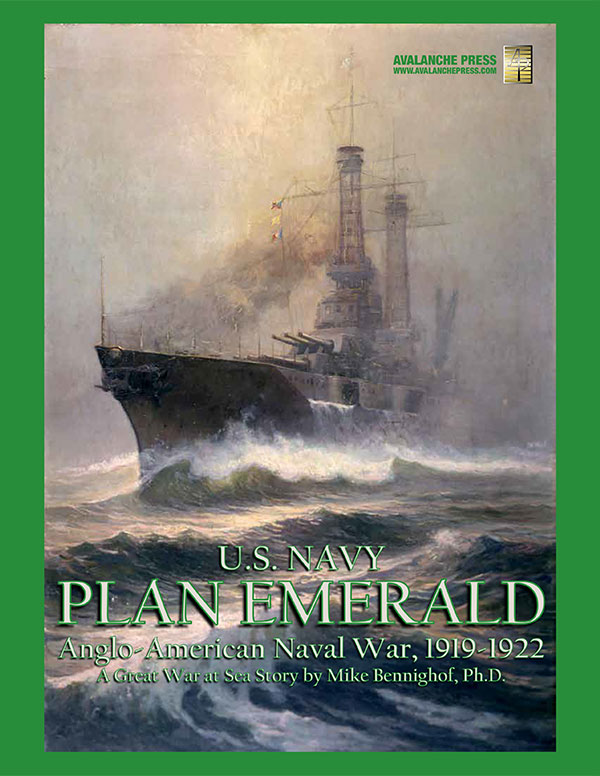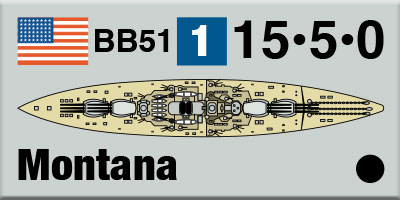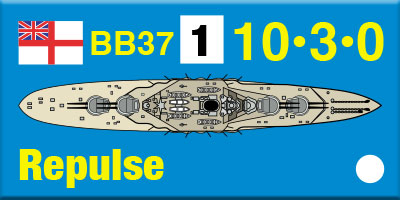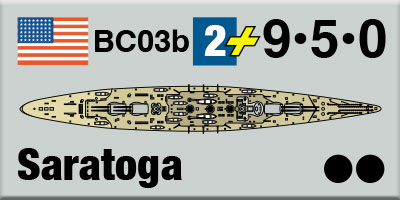| U.S. Navy Plan Emerald
Publisher’s Preview
By Mike Bennighof, Ph.D.
May 2024
 It took quite a while for me to accept that while wargamers like alternative history, the reason they like it is the story. Sure, you can craft a fun game out of an alternative situation – history is full of “what if” questions, with every decision large or small a potential inflection point. It took quite a while for me to accept that while wargamers like alternative history, the reason they like it is the story. Sure, you can craft a fun game out of an alternative situation – history is full of “what if” questions, with every decision large or small a potential inflection point.
To help usher in the new Second Edition of Great War at Sea, I decided that we should embark on a new alternative-history story arc. The Red-Orange Naval War posits a naval war between the United States on one side, and Japan (Orange) and Britain (Red) on the other. It begins with conflict over Ireland, as the United States offers diplomatic, financial and military support for the nascent Irish Republic and the British object most strenuously, with strongly-worded letters and naval gunfire.
We tell that story, about a war that never happened, in Great War at Sea: U.S. Navy Plan Emerald. There really was a Plan Emerald, though it never had much detail to it. In our story, the president of the revolutionary Irish Republic, the thoroughly unpleasant Éamon de Valera, makes his May 1919 visit to the United States in search of assistance. Since he held dual citizenship, he could maneuver in American political circles where other Irish leaders might be deported. This really happened, and he had some success raising money (a fair amount of which disappeared from sight) but very little in gaining official U.S. government backing.

In our version of the story, he’s more successful, and the United States at first allows private support in the form of arms and volunteers to travel to Ireland, followed by humanitarian aid from official sources, and by the spring of 1920 clandestine shipments of weapons started to arrive. In April 1920, even as the British-sponsored police abandoned the countryside, Royal Navy patrols found American-crewed steamers unloading not just rifles but artillery and ammunition. The Wilson administration, with its president in seclusion, denied any official sponsorship. Britain responded with a ban on American shipping entering British ports, calculating that American isolationist impulses would force Washington to back down. Instead, Woodrow Wilson, seeking his party’s nomination for the third term, asked Congress for a declaration of war, which passed by a narrow margin.

That’s the short version of our background premise; the book goes into much greater depth, because we like to tell you why everyone’s so angry. This story’s a variant of our Second Great War alternative history; in that story arc, Britain and the United States come to the brink of war, laying down many ships that we get to use later, but don’t actually engage in open war (so that all of those ships are still around in 1940).
U.S. Navy Plan Emerald is a Great War at Sea expansion book, and it comes with its own set of pieces (these originally appeared in our discontinued U.S. Navy Plan Red game). The action takes place on the map from Jutland Second Edition, and a great many ships from Jutland (which has a sizeable U.S. Navy contingent) get to see action, too. That’s all you’ll need: the U.S. Navy Plan Emerald book, and a copy of Jutland Second Edition.

U.S. Navy Plan Emerald is the first book we’ve done from the start based on the Second Edition rules for Great War at Sea. They play the same way as the first edition, and the pieces remain the same. But the book’s special rules and scenarios are geared to the new series rules.
The action begins slowly, as at first the Americans try to support their Irish Republican allies with fast cruisers delivering small quantities of materiel in isolated locations. The British attempt to lock down the island with a blockade, causing the Americans to respond with greater force. Eventually, they land their own troops and seize bases to support a fleet in British waters. That of course sparks a response from the re-instituted Grand Fleet.

That also means that we get to use all of the pieces from Plan Red, and a great many of them from Jutland Second Edition. As with all of our more recent expansion books whatever the series, the scenarios are grouped in chapters to help tell our story, with each operational scenario supported by a varying number of battle scenarios.
It’s still a Great War at Sea game, so that means that the dreadnought battleship rules the waves with airplanes an adjunct to the ships with the big guns. While many of the battles are fought by ships little different than those that saw action at Jutland (and include some of the very same ships), both fleets also add massive super-battleships armed with hull-crushing 18-inch guns.

The old U.S. Navy Plan Red was designed before we had a good concept of how to handle a game series. While the set of pieces was intended for a stand-alone game (and worked fine that way), in those days we didn’t make expansion books so we tried to build the mix of ships for alternative-history games like U.S. Navy Plan Red to be completely separate from those of other games. That made for some odd choices in the game, and the pieces really work better as the centerpiece of an expansion book. With the huge toybox that is Jutland from which to draw more ships, we can build some really fun scenarios including massive clashes of mighty battleships.
Heading the American battle line are four examples of the “battleship of the future” sketched by the U.S. Navy’s Bureau of Ordnance in August 1919 (we decided to pre-date it a little so we could use them in these scenarios). We named them the Oregon class, and they are powerful ships built around a main battery of eight 18-inch/48-caliber rifles in four twin turrets with a secondary battery of eighteen six-inch guns in six triple turrets. Almost as huge and powerful are four ships of the (first) South Dakota class, each armed with a dozen 16-inch guns.

The Royal Navy counters with monsters of its own: the four huge battleships of the N3 type, each armed with nine 18-inch guns, and the four battle cruisers of the G3 type, faster but “only” carrying nine 16-inch guns. The battleships have been labelled the Trafalgar class in this game, and the battle cruisers the Invincible class.
U.S. Navy Plan Emerald brings you lots of heavy metal on the water, and hot battleship action in the Irish Sea and neighboring areas. You get to use the left-hand side of the Jutland map, which is pretty cool (it doesn’t see much action in Jutland, the game). And you get a comprehensive story of alternative history to play through, rather than a shotgun pattern of more-or-less connected scenarios.
It’s a good package. You’re going to like it.
Click here to join the Gold Club.
See your Gold Club Insider newsletter for ordering information.
Sign up for our newsletter right here. Your info will never be sold or transferred; we'll just use it to update you on new games and new offers.
Mike Bennighof is president of Avalanche Press and holds a doctorate in history from Emory University. A Fulbright Scholar and NASA Journalist in Space finalist, he has published a great many books, games and articles on historical subjects; people are saying that some of them are actually good.
He lives in Birmingham, Alabama with his wife and three children. He misses his Iron Dog, Leopold.
Want to keep Daily Content free of third-party ads? You can send us some love (and cash) through this link right here.
|
